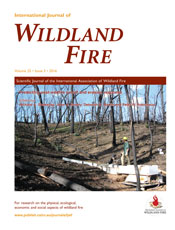International Journal of Wildland Fire
Volume 25
Number 3 2016
Predicting Post-wildfire Runoff and Erosion Response
This short paper is the foreword to a special issue of eight papers selected from those presented at a 2013 conference concerned with post-wildfire hydrogeomorphic impacts. Insufficient understanding of underlying controls to enable reliable and accurate prediction of runoff and erosion response was the raison d'être for organising the conference. Not only field scientists and practitioners but also, importantly, meteorologists and modellers were invited to attend. How the eight special-issue papers relate to the conference topics, their key findings and evaluations of their contributions to improved understanding are summarised. In addition, future research priorities are briefly outlined.
The runoff and sediment generation potential of fire-affected soils is a critical factor in determining the hydro–geomorphic response of burned landscapes. Aridity is a control on soil development, and here we show it is also a strong predictor of post-fire surface runoff generation and high-magnitude erosion processes such as debris flows.
The KINEROS2/AGWA model was used to compare several representations of post-fire rainfall events. Results indicated that radar depictions produced more accurate absolute runoff values than design storm depictions. However, risk assessment predictions of relative change between pre- and post-fire scenarios did not vary greatly between rainfall depictions.
Remote sensing is being widely used to detect landscape changes caused by wildfire and to provide detailed information for models. Our results show that remote sensing measures of these changes can be related to changes in soil properties that affect runoff. These relations will improve predictions of catastrophic floods from burned areas.
Clogging of soil pores by ash is often named as a factor causing increased surface runoff after fires, yet evidence for this is lacking. Using infiltration experiments with microscope observations, and analysis of surface charge and hydraulic conductivity, we were unable to provide this evidence using pure sands. This suggests that pore-clogging by ash is unlikely to be responsible for post-fire runoff from sands.
This study quantifies runoff and erosion across point to hillslope scales and evaluates connectivity of runoff and erosion processes for fragmented and burnt landscapes. The results clearly demonstrate hillslope hydrologic response is governed by water input and the connectivity of surface susceptibility, sediment availability, and runoff and erosion processes.
Post-wildfire debris flows have occurred as a result of several severe wildfires in the southern interior of British Columbia since 2003. Such events can present a significant hazard to public safety and infrastructure below burned areas. Debris flows have been triggered by spring snowmelt, high-intensity summer rain and long-duration fall rain.
The Erosion Risk Management Tool (ERMiT) provides probabilistic estimates of post-fire hillslope sediment delivery. Significant correlations with eight field sites suggest that ERMiT’s predictions provide reasonable estimates, and were able to capture the wide range of observed sediment delivery and approximate the effectiveness of common erosion mitigation treatments and site recovery.
Assessing the effectiveness of fuel treatments on reducing post-fire hydrologic response is an important challenge in fire management. We linked fuel treatment, wildfire and hydrological models spatially to measure the effects of fuel treatments on post-fire runoff and erosion in two case studies on National Park Service lands.




